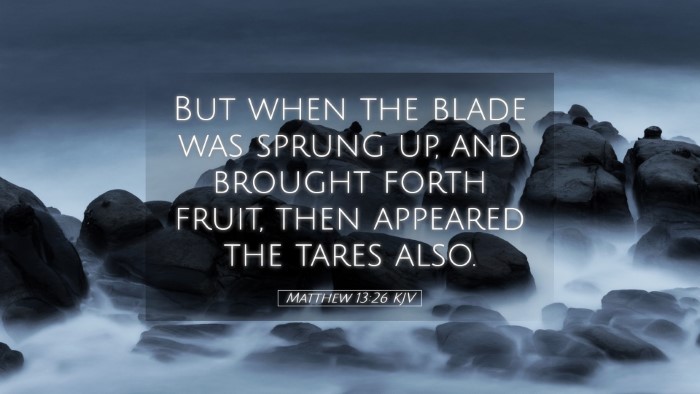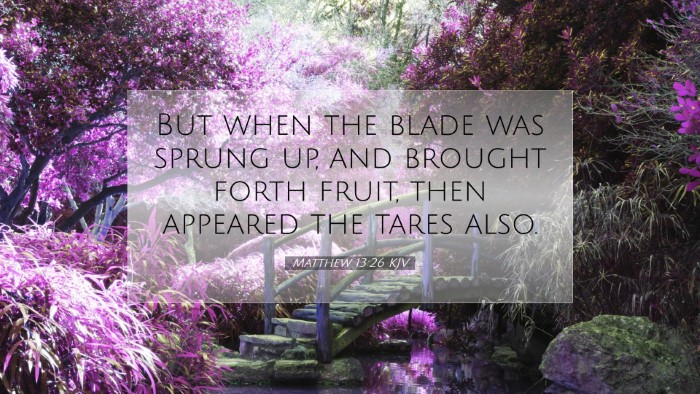Commentary on Matthew 13:26
Verse Reference: Matthew 13:26 - "But when the blade was sprung up, and brought forth fruit, then appeared the tares also."
Contextual Overview
This verse is a part of the Parable of the Tares, where Jesus uses agricultural imagery to convey spiritual truths. The narrative illustrates the coexistence of good and evil within the world and the eventual divine judgment that will separate the two.
Insights from Matthew Henry
Matthew Henry highlights that the growth of the blade signifies the progress of the gospel, where initial signs of life and faith are evident. However, it is at this stage that the tares—or counterfeit believers—become visible, illustrating the challenges inherent in the Christian community.
- Coexistence of Good and Evil: According to Henry, the presence of tares indicates that Satan has also been at work, sowing discord among the faithful.
- Importance of Discernment: Believers are called to exercise discernment between true faith and false appearances as the harvest approaches.
- God's Sovereignty: Henry emphasizes God’s ultimate control over the harvest season, reminding readers that divine justice will prevail at the appointed time.
Insights from Albert Barnes
Albert Barnes offers a detailed interpretation emphasizing the timing of the harvest and the growth process. He stresses that the blade springing up represents the early conversion experiences of believers, which might be overshadowed by the presence of evil.
- The Nature of Growth: Barnes notes that spiritual growth can be gradual, and the appearance of tares doesn't negate the validity of the wheat's growth.
- Future Accountability: He highlights that the full manifestation of the fruit will ultimately reveal the true nature of one’s faith, calling attention to the necessity of patience in faith.
- God's Justice: Barnes assures that God will deal appropriately with both the wheat and the tares, thus providing comfort to believers regarding divine justice.
Insights from Adam Clarke
Adam Clarke provides a theological lens through which this verse is viewed, noting that the term "tares" refers to a particular type of weed that closely resembles wheat in its early stages, emphasizing the danger of misidentification.
- False Believers: Clarke warns that the church must be vigilant against those who appear as genuine believers but are, in fact, tares among the wheat.
- Growth Experience: He reflects on the spiritual experiences of believers, indicating that just as the wheat grows, true believers will also face challenges that test their faith.
- Eschatological Perspective: Clarke brings in an eschatological element by discussing the final judgment that will distinguish the righteous from the wicked, affirming hope for believers.
Theological Implications
The exposition from these commentaries provides a rich theological framework for understanding Matthew 13:26. It raises important questions about the nature of faith and the presence of evil in the world.
- Human Responsibility: The coexistence of wheat and tares calls believers to take responsibility for their growth and to remain vigilant against falsehood.
- Understanding Grace: The growth process emphasizes the grace of God in allowing believers to grow amidst adversity and confusion.
- Hope and Expectation: The certainty of a future harvest reassures followers of Christ that their faith is not in vain, encouraging perseverance through trials.
Applications for Pastors and Theologians
Pastors and theologians can extract significant applications from this commentary:
- Discernment in Leadership: Church leaders are encouraged to cultivate a culture of discernment among the congregation to recognize genuine versus false faith.
- Encouragement in Growth: Encouraging believers in their spiritual growth journey allows them to recognize that trials may also be means of growth.
- Preparation for Judgment: Reminding congregants of the eventual harvest prompts reflection on their own spiritual state and the necessity of living in accordance with biblical teachings.
Conclusion
Ultimately, Matthew 13:26 serves as a profound reminder of the complexities of spiritual growth in a world where good and evil exist side by side. The insights from respected commentaries contribute to a deeper understanding of this parable, urging believers to be vigilant, discerning, and hopeful in their faith journey. As we await the final harvest, we are called to nurture the wheat in our lives while recognizing the presence of tares, trusting in God’s justice and sovereignty.


